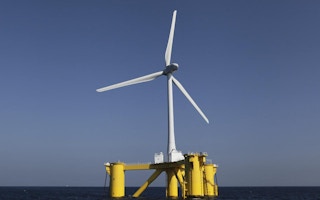A wind farm floating 20 km off the coast of Japan’s Fukushima Prefecture, home to the crippled Daiichi nuclear power plant, has successfully started powering turbines to feed energy to the grid, a spokesman for the project’s government-led consortium confirmed Tuesday.
The government-funded project, led by Marubeni Corporation, is Japan’s first step towards realizing a new, clean energy hub in the Fukushima area, which is still grappling with the devastating effects of a colossal earthquake triggering a massive tsunami that caused a triple meltdown at the stricken Daiichi facility.
The consortium said that the revolutionary wind farm which was brought online Monday will eventually have the capacity to generate 1 gigawatt of electricity from 143 turbines. Currently the project is powering a 2-megawatt turbine designed by Hitachi Ltd. and known locally as “Fukushima Mirai.”
The project’s substation is also floating offshore and represents one of the first of its kind and is called “Fukushima Kizuna.”
The word “kizuna” became a national designation in the weeks and months following the earthquake and tsunami battering Japan’s eastern seaboard on March 11, 2011, and roughly translates to ” bonds between people.”
Along with Marubeni Corp., Japan’s Ministry of Economy, Trade and Industry will now oversee the installation of two more turbines to augment the generating capacity of the floating wind farm, trade ministry officials said.
The trade ministry has earmarked 22 billion yen (around 222 million U.S. dollars) for the project’s expansion over the next five years and will look to pump an additional 31 billion yen ( about 312.48 million dollar) into the project from next April, the officials said.
Fukushima’s governor Yuhei Sato praised the efforts of the consortium, stating that the project represented a new lease of life for the prefecture and that the floating wind farm stood as a symbol of Fukushima’s future.
With all of Japan’s 50 nuclear power stations currently offline for safety inspections, the government has been looking at tapping into renewable sources of energy, such as solar, hydro and wind power as a weakening yen has seen import costs for fossil fuels sky rocket for resource-poor Japan who is looking to reduce its carbon emissions along with domestic policy and international protocols.
However, such forms of renewable energy are unlikely to make up for the shortfall of power as rectors here remain offline and the infrastructure, safety evaluations, noise and maintenance issues of offshore wind farms, for example, as well as the unpredictability of the generation capacity has had some of Japan’ s ruling Liberal Democratic Party (LDP), business lobbies and experts arguing that the ultimate solution to Japan’s energy crisis might not be so simple.
Experts highlight that all energy sources have their pros and cons and that wind power, despite being one of the cleanest forms of new power, lacks the generating capacity of other forms of energy.
Wind power’s average generating capacity is 2 watts per square meter compared to 20 watts per square meter for solar power and 1, 000 watts per square meter for nuclear power, an expert from Japan ‘s energy industry pointed out.
However, a spokesperson for the trade ministry said that the new wind farm off Fukushima marked the beginning of a push towards combining renewable power with conventional sources and that the project could be economically beneficial to the region and Japan at large as the new technology could be exported overseas.
“Thousands of people were injured or otherwise affected by the terrible accident at the Fukushima Daiichi nuclear power plant,” said Kazuyoshi Akaba, a vice minister at the trade ministry.
“To have a new source of clean energy based here is not just meaningful for those affected, but also the industry and the government will strive to ensure the project is a success,” he said.
Japan has more than 10 other wind farm projects currently underway and at various stages of completion, with experts stating that offshore wind power could generate as much as 1,600 gigawatts of power to supply the nation’s grids.










